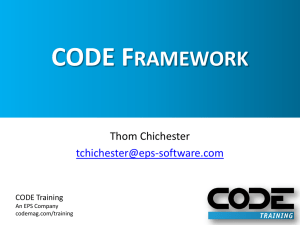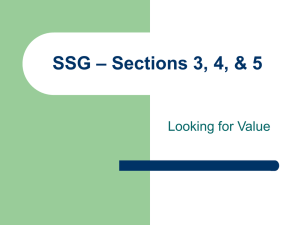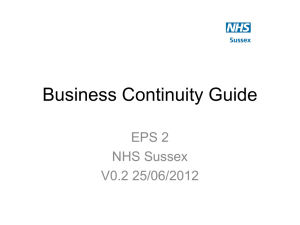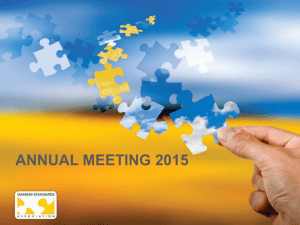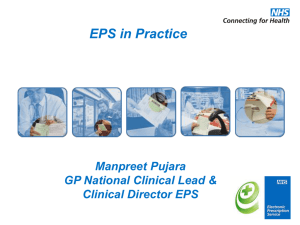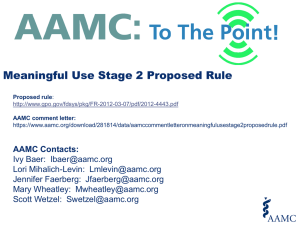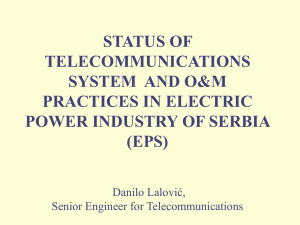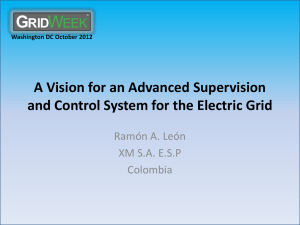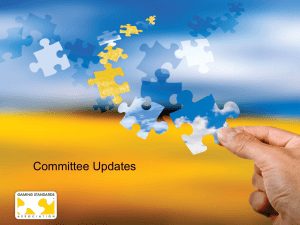G2S building block - Gaming Standards Association
advertisement
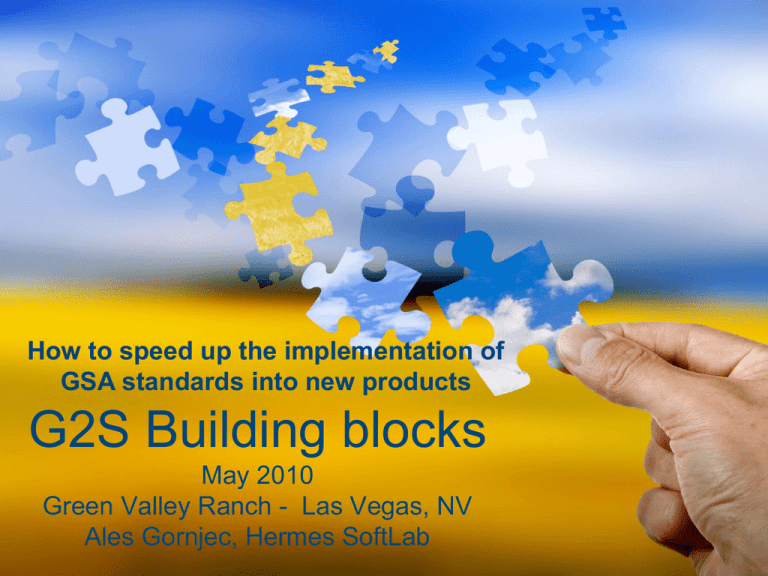
How to speed up the implementation of GSA standards into new products G2S Building blocks May 2010 Green Valley Ranch - Las Vegas, NV Ales Gornjec, Hermes SoftLab Agenda Why GSA and G2S Approach to providing G2S solutions to gaming machine vendors Why developing our own set of tools? Generic implementation versus specific Integration challenges and solutions G2S host and S2S protocol building blocks Slide 2 Hermes SoftLab At a glance HERMES SoftLab is an international provider of software engineering services & IT solutions Established: 1990 Member of ComTrade Group since 2008 Headquarters: Ljubljana, Slovenia, EU Employees: 850+ Main markets: gaming & storage industries telecommunication service providers financial institutions and the public sector Quality certificates: ISO-9001/TickIT by BSI Slide 3 The need for GSA and G2S? For heavily regulated industries (like gambling) standards are very important Single vendor environments are easier to build but – players require variety Standards break vendor lock-in situations First important steps already made Now certification program and GSA university are also available Slide 4 Complexity GSA Protocol sizes and growth started protocol BOB (2004) G2S (2006) S2S (2004) SAS* today (May 2010) classes pages classes pages 16 300+ replaced by G2S 22 1240 23 1825 7 15 375 25 1130 2 14 190 *SAS included only for comparison of spec and functionalities covered extensions Slide 5 Hermes decision and goals? Previous experience with industry standards Knowledge transfer from other segments (XML, SOAP, security) The need Due to its complexity G2S requires significant investments (time, resources, knowledge) Standards can’t be deployed successfully without wider vendor support Vendors are asking themselves: to develop or to buy and integrate? Implementation goals: Compatibility with vendor platforms (OS and language) Low resource consumption (ram and processing power) Easy integration Clear separation between protocol stack, integration and platform to allow easy maintenance Slide 6 Build or buy decision Buy (+) Shorter time line Portable design Clear and stable API Proper support for extensions Phased integration – low risk from the start Maintenance covered Internal resources not locked into long implementation project Build Full control No external dependencies Optimal implementation and integration into the platform Possibility to reuse platform features (persistence, logging, …) Slide 7 Timeline projection 1 1 /1 0 - 1 2 /1 0 7 /1 0 - 8 /1 0 C o re c la s s e s in te g ra tio n 6 /1 0 - 6 /1 0 F e a s ib ility w o rk s h o p C e rtific a tio n and v e rific a tio n 8 /1 0 - 1 1 /1 0 F u ll in te g ra tio n 7 /1 0 1 0 /1 0 1 /1 1 1 /1 1 - 7 /1 1 in te g ra tio n a n d p la tfo rm a d ju s te m e n ts 5 /1 0 - 7 /1 0 7 /1 0 - 9 /1 0 9 /1 0 - 1 0 /1 0 In itia l in v e s tig a tio n K n o w -h o w g a th e rin g In fra s tru c tu re im p le m e n ta tio n 7 /1 0 1 0 /1 0 - 6 /1 1 G 2 S C la s s im p le m e n ta tio n 1 0 /1 0 1 /1 1 1 /1 1 - 7 /1 1 in te g ra tio n a n d p la tfo rm a d ju s te m e n ts 7 /1 1 - 1 0 /1 1 1 0 /1 0 - 6 /1 1 C e rtific a tio n a n d v e rific a tio n G 2 S C la s s im p le m e n ta tio n 4 /1 1 7 /1 1 1 0 /1 1 Slide 8 Project – investigation & planning High level management decision: we need G2S! Project team is formed to study the protocol basics, investigate feasibility and prepare high level estimates takes 2 months, estimates 10 EM for basic implementation Implementation team is formed to prepare high level architecture, designs and project plan takes 3 months, plan to finish in 8 months, discovered that testing will be difficult and testing tools need to be developed or acquired ... Slide 9 Project risks When building own solution for G2S Resources Engineers Know how Product: Performance impact Interoperability Compliance When buying and integrating Platform compatibility External dependencies Difficult to evaluate quality in advance Slide 10 Platform requirements Persistent Memory usage G2S with three main classes: ~6 kB raw data (30kB with SQLite) G2S with all 23 classes: ~84 KB raw data (150kB with SQLite) Minimal system requirements Memory (RAM): 20 - 50 MB CPU consumption Game-cycle simulation: about 20ms/cycle That is 50 games per second can be simulated on a dual-core PC Slide 11 Phased integration process Main goal is to identify and mitigate risks as early as possible Designed in a way to answer critical questions early: Is platform able to fulfill G2S requirements ? Integration feasibility (interfacing, process and threading model, resource management...) ? Hardware: are CPU and memory resources sufficient ? NVRAM usage Prof of concept phase gives basic working integration Additional functionalities integration is dictated by customer and it’s priorities Final phase helps with certifications and product deployment Slide 12 Integration points and APIs High level API is easier to integrate Covers 90% of class functionality (ordinary use) Can be combined with raw G2S API for special cases Raw API is a direct mapping of G2S commands: Classes Commands Similar structures EGM Platform Adapter Persistency Adapter G2S Classes Application Services EGM Platform Technical Services Foundation (Platform Abstraction) Slide 13 Protocol versions and maintenance Currently 2 major G2S version branches (1.0.3 and 2.0.3) Only deployment of version 1.0.3 is publicly known Several S2S versions released Several version deployed Several dialects Interoperability problems quite common Maintenance cost can be considerable Upgrades to new versions Interoperability fixes Backward compatibility issues Using a generic implementation is a good path to Reduce costs, Reduce interoperability issues and Shorten time to market HSL host implementation provides multi-version support Slide 14 Supporting G2S tools Needed for stack development and testing Internal tools allow our own pace for supporting new versions Possibility to develop different incarnations Complex GUI for manual testing Console application for load/performance testing Scriptable client for test automation Slide 15 Testing Unit testing over 200 unit tests, cover all G2S commands System testing test cases for each class ( 30-100 test cases per class) Automation host simulator workflows Performance latency and CPU usage measurement Stress testing using command line EGM simulator EGM simulator instance with 200 game devices ~16MB of RAM for 1000 instances, 16GB RAM. Slide 16 Interoperability Problems seen: optional commands, elements and attributes protocol versioning protocol backward compatibility is not 100% problems with extensions How to improve: defensive approach to design and implementation design with multi-version in mind version and extension agnostic APIs design protocols need to improve in this area too Slide 17 What is still ahead of us Wider product support (both host and EGM side) Push seen from distributed gaming side (lotteries) Individual deployments with some operators Push in some jurisdictions Initial interoperability issues resolved Still a lot of work needed Improvements in products based on new features available Bigger push /need from operators will come after that Slide 18 Questions? Slide 19
